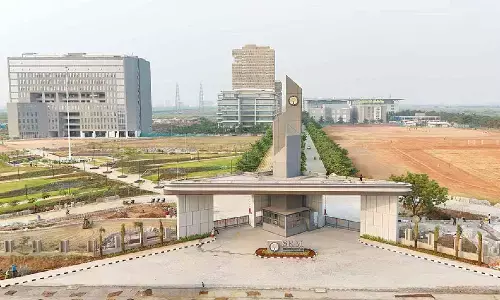Ecology and environment

Ecology is the scientific study of the reciprocal relation between organisms, including microbes, plants, animals as well as man, with their environment. The term ecology was coined in 1868 derived from two Greek words \"Oikos\" meaning home and \"Logos\" meaning study.
Ecology is the scientific study of the reciprocal relation between organisms, including microbes, plants, animals as well as man, with their environment. The term ecology was coined in 1868 derived from two Greek words "Oikos" meaning home and "Logos" meaning study.
Subdivisions of ecology:
There are three main subdivisions of ecology
1) Autecology: Study of the ecology of an individual with relation to the environment.
2) Synecology: Study of the ecology of groups or communities in relation to the environment.
3) Habitat ecology: Descriptive study of both the organisms and the kind of the environment or habitat where organisms live.
Environment:
The term environment is defined as "the sum total of living, non-living components; influences and events, surrounding an organism". The relationship and interaction between organism and environment are highly complex. Environment is broadly divided into two components: ABIOTIC or nonliving, BIOTIC or living.
The environment is not static. The biotic and abiotic factors are in a flux and keep on changing continuously. The organisms can tolerate changes in the environment within a certain range called "range of tolerance".
There are two types of environments: internal and external. Internal environment is possessed by living organisms enclosed by the outer body surface. The environment outside the body surface is called external environment. The internal environment is relatively stable as compared to the external environment, but is disturbed during infection or injury etc.
Ecosystem:
The complex natural organisation with their living and non-living environments that controls them and from which the living organisms derive their sustenance are technically called as ‘Ecosystem’ or an ‘ecological system’.
Components of ecosystem:
The components can be categorised into abiotic and biotic.
Abiotic components:
The important abiotic components are
a) Energy: basically from sun is essential for maintenance of life.
b) Materials: (a) Organic- Proteins, carbohydrates, lipids, humic substances. (b)inorganic compounds- oxygen, Nitrogen, Carbon, CO2, water, phosphate etc which are essential for organisms to survive.
c) Climatic factors: light, heat, temperature, wind, humidity, rainfall etc.
d) Edaphic factors: structure and composition of soil also exert significant influence on the organisms.
Biotic components:
Biotic components include living organisms comprising plants, animals and decomposers and are classified according to their functional attributes into producers and Consumers.
a) Producers: Autotrophs ( self-nourishing) are green plants as they synthesise carbohydrates from simple inorganic raw materials like carbon dioxide and water in the presence of Sunlight by the process of photosynthesis for themselves, indirectly for other non-producers. In Terrestrial ecosystem, producers are basically herbaceous and woody plants while in marine and freshwater ecosystem producers are various species of microscopic algae.
b) Consumers: Heterotrophs (other nourishing) are incapable of photosynthesis and depend on organic food derived from animals, plants or both. Consumers can be divided into two broad groups namely macro and micro consumers.
(i) Macro consumers: phagotrophs feed on plants or animals or both and are categorised on the basis of their food sources. Herbivores are primary consumers which feed mainly on plants e.g cow, rabbit. Carnivores feed only on animals. Secondary consumers feed on primary consumers e.g wolves. Carnivores which feed on secondary consumers are called tertiary consumers e.g Lions which can eat wolves. Organisms which consume both plants and animals are called omnivores e.g man. (ii) Micro Consumers: Saprotrophs ( decomposers or osmotrophs) are chiefly bacteria and fungi which obtain energy and nutrients by decomposing dead organic substances ( detritus) of plant and animal origin.
Size of ecosystem:
Ecosystems can be simple as well as complex. Cow dung is an example of simple ecosystem. Oceans or biosphere itself are an examples of complex ecosystem. Multiple ecosystems can occur within ecosystems. Example cow dung ecosystem may be contained in a forest ecosystem which is contained in the biosphere.
Ecosystems can have well defined boundaries as in pond ecosystem whereas in case of forests, grasslands and deserts there are no sharp boundaries. These ecosystems are often separated from adjacent ecosystems by a transition zone or a diffused boundary zone called "ecotone". Organisms of adjacent ecosystems intermingle in the ecotone; consequently they may have greater diversity of species than the neighbouring ecosystems.
Types of ecosystem: Basically ecosystems are of two types terrestrial and aquatic. Deserts, grasslands, crop fields, forests and glaciers represent different terrestrial ecosystems. Oceans, estuaries, mangroves, coastal marshes, rivers, lakes, ponds and swamps are examples of aquatic ecosystem.
Types of communities:
On the basis of size and degree of relative independence communities can be divided into two types:
1) Major communities: These are large-sized, well organised and relatively independent. They depend only on the sun's energy and are independent of the inputs and outputs from adjacent communities. A tropical evergreen forest in the North Eastern India is a good example of this community.
2) Minor communities: These are dependent on neighbouring communities and are often called societies. They are secondary aggressions within a major community and are not therefore completely independent units as far as energy and nutrient dynamics are concerned. A cow dung pad is an example of this community.
Biosphere:
Biosphere is that part of earth where life can exist. It is a narrow layer around the surface of the earth. Biosphere represents a highly integrated and interactive zone comprising of atmosphere, hydrosphere and lithosphere. Biosphere is absent at the extremes of North and South poles, the highest mountains and the deepest oceans, since existing conditions there do not support life.
Occasionally spores of bacteria and fungi do occur at great height beyond 9000 metres, but they are not metabolically active, and hence represent only dormant life. The energy required for the life within the biosphere comes from the sun. The nutrients necessary for living organisms come from air, water and soil and not from outside.
The same chemicals are recycled over and over again for life to continue. Living organisms are not uniformly distributed throughout the biosphere. Only a few organisms live in the polar regions while the tropical rain forests have an exceedingly rich diversity of plants and animals.
Functions of an ecosystem:
An ecosystem is a dynamic system characterized by energy flow and nutrient cycling. Substances constantly flow through it and there are sufficient supplies of energy within the ecosystem to enable this flow to take place. Ecosystems also possess considerable self-regulating ability, called homeostasis, due to which they can recover from minor perturbations.
There are three broad functions of an ecosystem:
1) energy flow
2) nutrient cycling (biogeochemical cycles)
3) ecological succession or ecosystem development.
1)Energy flow: Energy is the basic force responsible for all metabolic activities. The flow of energy in the ecosystem takes place from producer to top consumer in uni-direction.
Trophic level interactions:
In an ecosystem, the various biotic components are related to each other in the form of food chains. If we group all organisms in a food chain according to the general source of nutrition, we can assign them different trophic (feeding) levels. The producer organisms belong to first trophic level, primary consumers to the second trophic level, secondary consumers to the third trophic level and tertiary consumers to the fourth trophic level.
There are usually 5 or more trophic levels and seldom more than 6. Energy flows through the trophic levels from producers to subsequent trophic levels. This energy always flows from lower to higher trophic level. It never flows in the reverse direction that is from carnivore to herbivore to producers. There is a loss of some energy in the form of usable heat at each trophic level leading to a decrease in energy from the first trophic level upwards.
Pyramid of numbers:
Graphic representation of the total number of individuals of different species belonging to each trophic level in an ecosystem is known as pyramid of numbers. The length of each bar represents the total number of individuals at each trophic level in an ecosystem. The number of individuals drastically decrease with a step towards higher trophic levels and assumes pyramidal shape and is called pyramid of numbers.
The higher trophic levels are occupied by relatively large sized animals which are less abundant due to the fact that animals at higher trophic levels are larger than animals which they capture from the lower trophic levels. For most ecosystems pyramids of numbers are upright because the organism number decrease at successively higher trophic levels. However, there are some ecological systems for which pyramid of numbers is inverted. Example of inverted pyramid of numbers is the situation of a single tree along with its dependent insect population.
It is very difficult to count all the organisms in a pyramid of numbers and so the pyramid of numbers does not completely define the trophic structure for an ecosystem.
Pyramid of biomass:
To overcome the shortcomings of the pyramid of numbers, the pyramid of biomass is used. Biomass represents the total dry weight of living beings of different species at each trophic level at a particular time. For most ecosystems on land the pyramid of biomass has a larger base of primary producers with a smaller trophic level perched on the top i.e an upward pyramid. In contrast, in many aquatic ecosystems the pyramid of biomass may assume an inverted form. This is because the producers are tiny phyto-planktons that grow and reproduce rapidly.
Pyramid of energy:
To compare the functional roles of the trophic levels in an ecosystem an energy pyramid is the most informative. It overcomes some of the objections pertaining to the pyramid of numbers and biomass. Energy pyramid more accurately reflects the laws of thermodynamics, with loss of energy being depicted at each transfer to another trophic level, hence the pyramid is always upright even where the pyramid of biomass is inverted. Energy pyramid concept helps to explain the phenomenon of biological magnification - the tendency for toxic substances to increase in concentration progressively at higher levels of the food chain.
Food chain:
In a food chain, the food energy is transformed from a given source through a series of species, each of which eats even before itself in the chain. A sequence of organisms that feed on one another form a food chain. Food chain starts with producers and ends with top carnivores.
Types of food chains:
Based on the kinds of organisms that constitute the first trophic level, three types of food chains can be distinguished:
i) Grazing food chain: The consumers which start the food chain utilising the plant or plant part as their food constitute the grazing food chain.
ii) Detritus food chain: Detritus food chains begin with dead organic matter which is an important source of energy. Various species of microscopic fungi, bacteria and other saprophytes, play a prominent role in decomposing organic matter to obtain energy needed for the survival and growth. In this process they release various nutrients logged in dead organic matter which are readily used by the green plants. Detritus food chains are interconnected with grazing food chains and other auxiliary food chains.
iii) Auxiliary food chains: food chains operated through parasites and scavengers are called auxiliary food chains.
2) Nutrient Cycling: The nutrient cycling describes how nutrients move from physical environment to the living organisms, and subsequent recycling back to the environment. This movement of nutrients is essential for life to sustain and is a vital function of the ecology of any region. Nutrient cycles are of two types Gaseous cycle and Sedimentary cycle. Gaseous cycles are perfect nutrient cycles because the nutrients are replaced as fast as they are consumed whereas Gaseous cycles are called imperfect nutrient cycles as some nutrients are lost from the cycle and get locked into sediments and become unavailable for immediate recycling. Examples of gaseous cycles are hydrological, carbon cycle and nitrogen cycle. Examples of sedimentary cycles are phosphorous and sulphur cycle.
3) Ecological succession: Succession is a process in which a biotic community destroyed by natural or human causes is gradually replaced in a series of changes, through a series of intermediate successional changes leading to a climax stable community. Succession is a universal process of directional change in vegetation, on an ecological timescale. Succession is of two types: primary and secondary succession.
Primary succession:
Succession taking place in bare areas where no community existed before is called primary succession. In this succession the new site is colonised by a few pioneer species that are often microbes, lichens and mosses. These pioneers alter the conditions of the place and make it suitable for other species to live until a climax community is established.
Secondary succession:
Secondary succession is the sequential development of biotic communities after the existing community is partially or completely destroyed. A mature or intermediate community may be destroyed by natural events such as floods, droughts or fires or by human intervention such as deforestation, overgrazing etc.
The differences between primary and secondary succession is that the secondary succession occurs on a well-developed soil. Thus secondary succession is relatively faster as compared to primary succession.
By: P Bala Brahmaiah




















